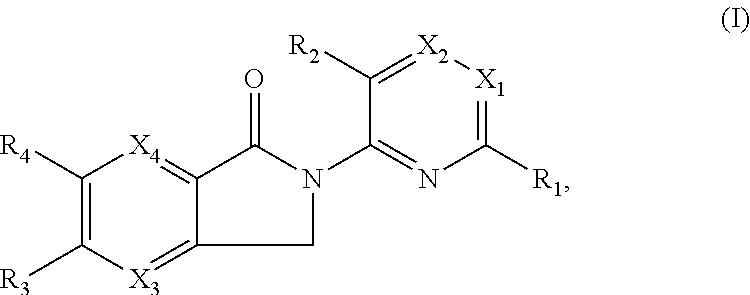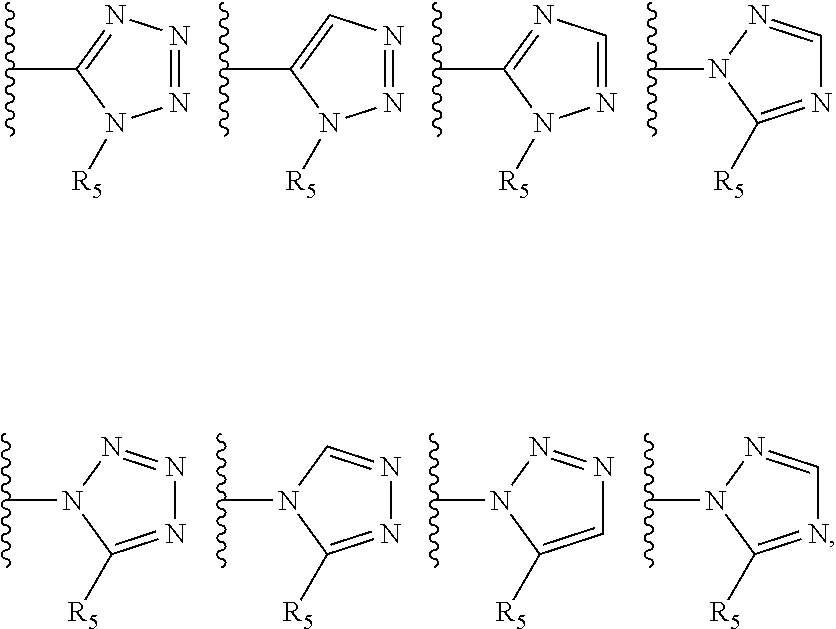Tetrazole containing apoptosis signal-regulating kinase 1 inhibitors and methods of use thereof
- Summary
- Abstract
- Description
- Claims
- Application Information
AI Technical Summary
Benefits of technology
Problems solved by technology
Method used
Image
Examples
example 1
6-(4-cyclopropyl-1H-imidazol-1-yl)-2-(6-(5-isopropyl-1H-tetrazol-1-yl)44yridine-2-yl)isoindolin-1-one
[0186]
[0187]To a solution of 6-(4-cyclopropyl-1H-imidazol-1-yl)isoindolin-1-one (70.7 mg, 0.295 mmol) in 1,4-dioxane (0.8 mL) was added 2-bromo-6-(5-isopropyl-1H-tetrazol-1-yl)pyridine (66.0 mg, 0.246 mmol), Pd2(dba)3 (11.3 mg, 0.012 mmol), Xantphos (14.2 mg, 0.025 mmol) and Cs2CO3 (160 mg, 0.492 mmol). The reaction was purged with N2 and allowed to stir at 80° C. for overnight. The reaction was concentrated, and the residue was purified by chromatography on silica gel using 0->70% acetone in hexanes to afford 32.1 mg white solid as Example 1 (31% yield). LC-MS [M+H]=427.19, Calcd. 427.19. 1H NMR (400 MHz, DMSO-d6) δ8.76 (d, J=8.4 Hz, 1H), 8.33-8.26 (m, 2H), 8.08 (d, J=2.1 Hz, 1H), 8.01 (dd, J=8.2, 2.2 Hz, 1H), 7.88 (d, J=8.3 Hz, 1H), 7.77 (dd, J=7.8, 0.7 Hz, 1H), 7.69 (d, J=1.5 Hz, 1H), 5.17 (s, 2H), 3.94 (p, J=6.8 Hz, 1H), 1.90-1.81 (m, 1H), 0.85-0.80 (m, 2H), 0.75-0.70 (m, 2H).
example 2
6-(4-cyclopropyl-1H-imidazol-1-yl)-2-(6-(1-isopropyl-1H-tetrazol-5-yl)45yridine-2-yl)isoindolin-1-one
[0188]
[0189]Example 2was prepared by using similar procedure as described for compound of example 1.
[0190]LC-MS observed [M+H], 427.19, Calcd. 427.19. 1H NMR (400 MHz, DMSO-d6) δ8.78 (d, J=8.5 Hz, 1H), 8.30 (d, J=1.5 Hz, 1H), 8.22 (dd, J=8.5, 7.6 Hz, 1H), 8.09 (d, J=2.2 Hz, 1H), 8.05-8.00 (m, 2H), 7.90 (d, J=8.5 Hz, 1H), 7.69 (d, J=1.5 Hz, 1H), 5.90-5.79 (m, 1H), 5.25 (s, 2H), 1.93-1.82 (m, 1H), 1.70 (d, J=6.9 Hz, 6H), 0.88-0.80 (m, 2H), 0.76-0.72 (m, 2H).
example 3
I-2-(5-(6-(6-(4-cyclopropyl-1H-imidazol-1-yl)-1-oxoisoindolin-2-yl)45yridine-2-yl)-1H-tetrazol-1-yl)propyl acetate
[0191]
[0192]Example 3 was prepared by using similar procedure as described for Example 1. LC-MS observed [M+H], 485.20, Calcd. 485.20. 1H NMR (400 MHz, DMSO-d6) δ8.78 (dd, J=8.5, 0.9 Hz, 1H), 8.29 (d, J=1.5 Hz, 1H), 8.23 (dd, J=8.5, 7.6 Hz, 1H), 8.09 (d, J=2.1 Hz, 1H), 8.07 (dd, J=7.6, 0.9 Hz, 1H), 8.03 (dd, J=8.2, 2.2 Hz, 1H), 7.87 (d, J=8.2 Hz, 1H), 7.69 (d, J=1.5 Hz, 1H), 6.13 (td, J=7.5, 4.0 Hz, 1H), 5.22 (s, 2H), 4.64 (dd, J=11.6, 4.0 Hz, 1H), 4.50 (dd, J=11.6, 8.1 Hz, 1H), 1.87 (td, J=8.4, 4.2 Hz, 1H), 1.81 (s, 3H), 1.75 (d, J=6.9 Hz, 3H), 0.88-0.80 (m, 2H), 0.75-0.68 (m, 2H).
PUM
 Login to View More
Login to View More Abstract
Description
Claims
Application Information
 Login to View More
Login to View More - R&D
- Intellectual Property
- Life Sciences
- Materials
- Tech Scout
- Unparalleled Data Quality
- Higher Quality Content
- 60% Fewer Hallucinations
Browse by: Latest US Patents, China's latest patents, Technical Efficacy Thesaurus, Application Domain, Technology Topic, Popular Technical Reports.
© 2025 PatSnap. All rights reserved.Legal|Privacy policy|Modern Slavery Act Transparency Statement|Sitemap|About US| Contact US: help@patsnap.com



